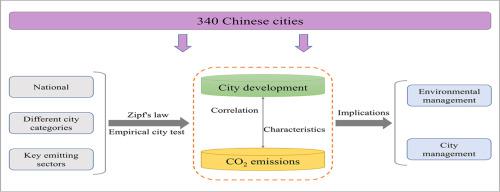Science of the Total Environment ( IF 8.2 ) Pub Date : 2020-12-03 , DOI: 10.1016/j.scitotenv.2020.143912 Jing Wei , Jianjun Zhang , Bofeng Cai , Ke Wang , Sen Liang , Yuhuan Geng

|
Carbon emissions and city development are currently two major areas of interest worldwide. With the continuous development of cities, the problem of carbon emissions has received substantial attention. Analyzing the relationship between carbon emissions and city development is key to building low-carbon cities. This paper selects the revised Zipf's law to explore diverse carbon emission characteristics in different stages of city development and tries to verify the balance of city development and the rationality of key emitting sectors in China, thus filling a gap in this domain. Based on the analysis of different emitting sectors and diverse city categories, several discoveries are made. First, nearly 80% of Chinese cities have reached the ideal state of Zipf's law between carbon dioxide (CO2) emissions and city development. In general, carbon emissions and city development are basically matched at the present stage. Second, in cities, the carbon emissions of the agricultural and industrial processes sectors are relatively balanced and stable with the city development. In addition, only the traffic sector is in the stage of intensive development. Other sectors (industrial energy, rural household, urban household, services, and indirect emissions) need to be further optimized. Third, CO2 emissions in other type of cities are basically matched with the city development. Industrial cities, megalopolises and metropolises are in the stage of intensive development, while cities of other types (service-oriented cities and small-medium cities) need to be further optimized. Fourth, corresponding measures, such as adjusting energy and industrial structure, optimizing resource allocation, and promoting intensive production, need to be taken to optimize carbon emissions in cities of different types and in different emitting sectors. Our study provides a particular theoretical basis and practical value, for China and other countries in similar situations, to coordinate the matching correlation between city development and carbon emissions in the future.











































 京公网安备 11010802027423号
京公网安备 11010802027423号